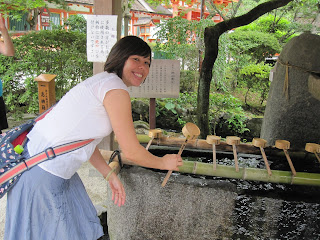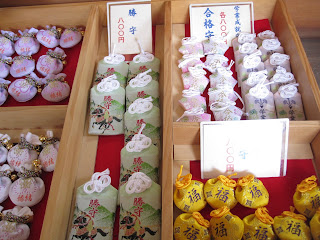This gate is called a torii, and is used to mark entrances to sacred places. Shinto shrines will typically have at least a few of these as you go from one area of the shrine to another. Today I learned the significance of the paper, leaves, and ropes hanging from the larger rope--they are meant almost as agricultural good luck charms. The paper represents lightning, the rope rain, and the leaves earth I think? Together they refer to the various forces of nature that come to bear on the harvest.
Kamigamo is famed for these two perfectly shaped cones of sand. They are an allusion to Ko-yama, the sacred mountain that was the original site of worship for this shrine's kami, Wakeikazuchi (the kami of dividing thunder). What was intriguing to me was the background behind the fact that there are two. The Shinto priest explained that this is reflective of the principle of yinyang, the idea that all things in the world are comprised of a balance of opposite pairs. I'm familiar with that of course, because it's Chinese Daoism. I had no idea that Shinto had absorbed some of the philosophies of Daoism.
These are wishes written on little wooden tablets by visitors to the shrine.
The crossing of water is a important component to a shrine, apparently, as a it indicates purification. There were three bridges in this shrine.
Before you enter the shrine, you need to purify yourself by washing your hands and rinsing your mouth. Using the ladle, first you clean your left hand, then your right. Then you rinse your mouth. Finally, you tilt the remaining water so that it runs down the ladle, purifying it for the next person.
Here is the bell and bow scene we're so familiar with from anime. First you bow, then ring the bell to get the kami's attention. You toss a coin in as an offering, then bow twice, clap twice, and bow again.
This particular side-shrine was once visited by Lady Murasaki, the author of the classical piece of Japanese literature, the Tale of Genji. Thus, the little wooden wish boards bear a picture of her. You'll notice that some of the boards have the wish written visibly on the back, while others have place a white sticker on top of their wish so no one can read it. The little green leaf shapes on the back are hollyhock, as Kamigamo Shrine hosts one of the biggest festivals of the year, the Aoi Matsuri, or Hollyhock festival. During this festival on May 15, there is an imperial procession from Shimigamo Shrine, located 2km away, ending here at Kamigamo.
Before going into the main building, we had to remove our shoes.
The shrine office sells charms for all kinds of things, like happiness, protection, and health.
The deity enshrined at Kamigamo is called Wakeikazuchi, and he is a kami of thunder. Originally, an stone altar was erected on the sacred mountain, Ko-yama, from which he ascended and descended. You can just barely see the mountain in this picture. It's more of a hill really. Later, in 678, the shrine structures were built. Today, no one ascends the mountain, as it is a sacred place.
These are wishes written on little wooden tablets by visitors to the shrine.
The crossing of water is a important component to a shrine, apparently, as a it indicates purification. There were three bridges in this shrine.
Before you enter the shrine, you need to purify yourself by washing your hands and rinsing your mouth. Using the ladle, first you clean your left hand, then your right. Then you rinse your mouth. Finally, you tilt the remaining water so that it runs down the ladle, purifying it for the next person.
Here is the bell and bow scene we're so familiar with from anime. First you bow, then ring the bell to get the kami's attention. You toss a coin in as an offering, then bow twice, clap twice, and bow again.
This particular side-shrine was once visited by Lady Murasaki, the author of the classical piece of Japanese literature, the Tale of Genji. Thus, the little wooden wish boards bear a picture of her. You'll notice that some of the boards have the wish written visibly on the back, while others have place a white sticker on top of their wish so no one can read it. The little green leaf shapes on the back are hollyhock, as Kamigamo Shrine hosts one of the biggest festivals of the year, the Aoi Matsuri, or Hollyhock festival. During this festival on May 15, there is an imperial procession from Shimigamo Shrine, located 2km away, ending here at Kamigamo.
Before going into the main building, we had to remove our shoes.
The shrine office sells charms for all kinds of things, like happiness, protection, and health.
The deity enshrined at Kamigamo is called Wakeikazuchi, and he is a kami of thunder. Originally, an stone altar was erected on the sacred mountain, Ko-yama, from which he ascended and descended. You can just barely see the mountain in this picture. It's more of a hill really. Later, in 678, the shrine structures were built. Today, no one ascends the mountain, as it is a sacred place.
After our visit, we got to meet with the head priest of the shrine. We were offered tea and sweets. He gave us a little bit of explanation of the shrine, but the most interesting part was when Kazuko and Rob presented him with a monetary gift from Japan Society. He was clearly about to leave, but when he received the gift he turned back around and launched into a long explanation of Shinto shrine carpentry. Apparently there is a system in place where the shrines are rebuilt/restored every 20 years, partly because the way they are constructed means they need it, partly because (and this was implicit, not directly said) there needs to be an institutionalized way to maintain the knowledge of Shinto carpentry. His explanation went on for a good ten minutes as he went into great detail about how the buildings are constructed and so forth. He ended with, "And so your gift will help us maintain the building," and it wasn't until that moment that I realized that this whole talk was just an elaborate way of saying thank you! It was kind of amazing.














No comments:
Post a Comment